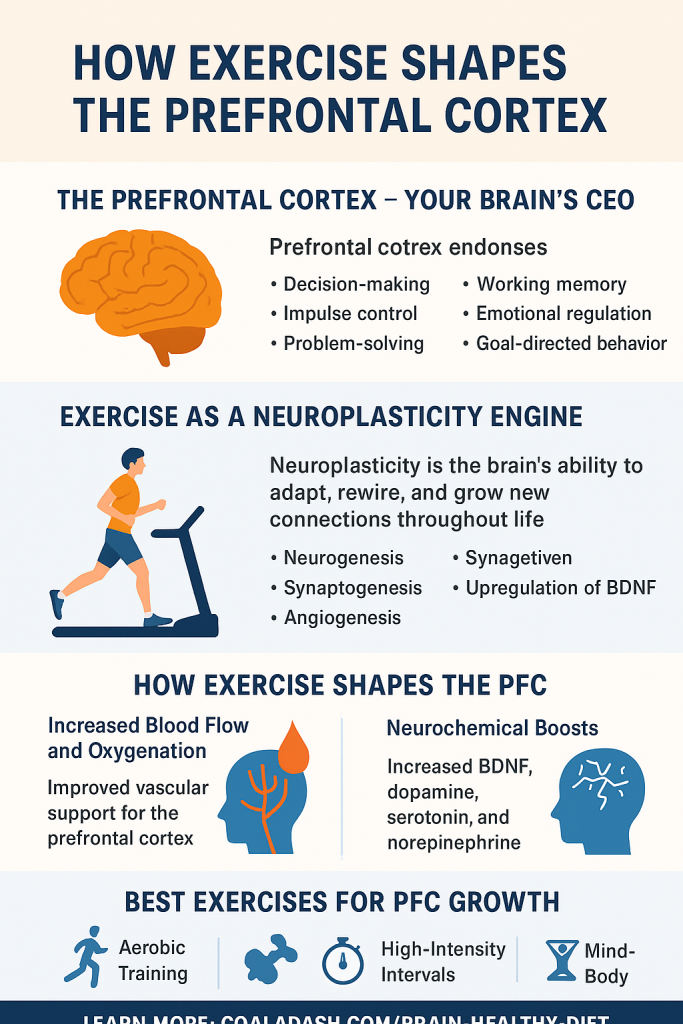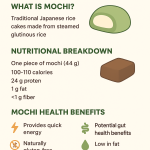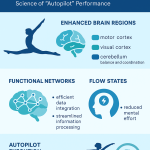Introduction: Exercise and the Prefrontal Cortex Connection
How does exercise shape the prefrontal cortex? The connection between physical movement and brain function is one of the most fascinating areas of neuroscience today. Research shows that exercise doesn’t just improve your heart, muscles, and mood—it literally changes your brain. Studies reveal that consistent physical activity increases gray matter volume, neuroplasticity, and cognitive flexibility in the prefrontal cortex, the part of the brain responsible for decision-making, focus, planning, and emotional regulation.
In this comprehensive guide, we’ll explore:
- The role of the prefrontal cortex in human behavior
- How exercise stimulates structural and functional changes in the brain
- A breakdown of scientific studies showing exercise-driven neuroplasticity
- The best forms of exercise for prefrontal cortex health
- Practical ways to incorporate brain-boosting movement into daily life
By the end, you’ll understand not only why exercise is vital for your body but also how it shapes the very part of your brain that makes you who you are.
The Prefrontal Cortex – Your Brain’s CEO
What Is the Prefrontal Cortex?
The prefrontal cortex (PFC) is often called the brain’s CEO because it manages higher-order cognitive functions. Located just behind the forehead, it plays a central role in:
- Decision-making
- Impulse control
- Problem-solving
- Working memory
- Emotional regulation
- Goal-directed behavior
Unlike reflexive brain regions, the PFC allows you to pause, reflect, and choose deliberately. It’s what separates humans from most other animals in terms of complex planning and foresight.
Why the Prefrontal Cortex Declines Without Stimulation
Unfortunately, the PFC is also one of the first brain regions to decline with aging and chronic stress. Studies show that reduced gray matter volume in the prefrontal cortex is linked with:
- Poor attention control
- Increased anxiety and depression
- Lower cognitive flexibility
- Reduced working memory
This is where exercise becomes crucial—it offers one of the most reliable, evidence-backed interventions to protect and even grow the prefrontal cortex.
Exercise as a Neuroplasticity Engine
What Is Neuroplasticity?
Neuroplasticity is the brain’s ability to adapt, rewire, and grow new connections throughout life. For decades, scientists believed brain development plateaued in adulthood. Now, research confirms that the adult brain remains plastic—especially in response to enriched environments and movement.
Exercise is one of the strongest promoters of neuroplasticity. Physical activity sparks:
- Neurogenesis – the birth of new neurons
- Synaptogenesis – the creation of new synaptic connections
- Angiogenesis – the growth of new blood vessels, improving brain oxygen supply
- Upregulation of BDNF (Brain-Derived Neurotrophic Factor) – a protein that protects neurons and enhances synaptic efficiency
The Link Between Exercise and Gray Matter Volume
One of the most robust findings in neuroscience is that exercise increases gray matter volume, particularly in the prefrontal cortex and hippocampus. Gray matter contains most of the brain’s neuronal cell bodies and is directly linked to cognitive capacity.
A 2010 study published in PNAS showed that older adults who walked regularly for a year had measurable increases in gray matter volume in the prefrontal cortex compared to a control group. This suggests that movement doesn’t just slow decline—it can reverse it.
Key Studies on Exercise and the Prefrontal Cortex
Aerobic Exercise and PFC Function
- Study: Colcombe et al. (2006)
- Finding: Aerobic fitness training increased brain volume in both gray and white matter, particularly in the PFC.
- Impact: Improved executive function tasks like task-switching and conflict resolution.
Resistance Training and Cognitive Control
- Study: Liu-Ambrose et al. (2010)
- Finding: Older women engaging in strength training twice a week showed significant improvements in executive functions compared to those who only did balance and toning exercises.
- Impact: Suggests resistance training protects against age-related PFC decline.
High-Intensity Interval Training (HIIT) and Neuroplasticity
- Study: Tsukamoto et al. (2016)
- Finding: HIIT increased BDNF levels more than moderate continuous exercise, boosting neuroplastic potential in the PFC.
- Impact: Short, intense exercise bursts may be especially potent for cognitive health.
Yoga and Mind-Body Practices
- Study: Gothe et al. (2013)
- Finding: Eight weeks of yoga improved working memory and executive function while reducing stress—benefits tied to structural changes in the PFC.
- Impact: Suggests movement with mindfulness synergizes physical and cognitive benefits.
Mechanisms – How Exercise Shapes the PFC
Increased Blood Flow and Oxygenation
Exercise enhances cerebral blood flow, delivering oxygen and nutrients essential for neuronal survival. The prefrontal cortex, highly metabolically active, thrives with improved vascular support.
Neurochemical Boosts
Movement triggers a cascade of neurochemicals:
- BDNF: Promotes synaptic plasticity and neuron survival
- Dopamine: Enhances motivation and reward processing in the PFC
- Serotonin: Regulates mood and emotional control
- Norepinephrine: Improves alertness and focus
Stress Reduction and Cortisol Regulation
Chronic stress shrinks the PFC while enlarging the amygdala (the fear center). Exercise reduces cortisol levels, helping restore PFC-amygdala balance.
Structural Remodeling
Over time, consistent exercise leads to:
- Thicker cortical layers in the PFC
- More efficient neural networks
- Stronger white matter tracts connecting PFC to other brain regions
Best Types of Exercise for Prefrontal Cortex Growth
Aerobic Training
Walking, running, cycling, and swimming have the most consistent evidence for boosting gray matter volume. Aim for at least 150 minutes per week of moderate-intensity aerobic activity.
Strength Training
Lifting weights twice per week is associated with executive function gains, especially in older adults.
High-Intensity Intervals
Short bursts of high effort (like sprinting or circuit training) rapidly increase BDNF levels.
Mind-Body Practices
Yoga, tai chi, and dance blend physical activity with coordination and mindfulness, further stimulating neuroplasticity.
Practical Ways to Integrate Brain-Boosting Movement
Micro-Workouts for Busy Schedules
Even 10-minute brisk walks during work breaks can boost PFC activation.
Exercise + Learning
Studies suggest exercising before studying enhances memory consolidation—ideal for students or professionals.
Social Exercise
Group classes or team sports not only boost fitness but also engage social cognition, another PFC-driven skill.
Future Research – Where Science Is Heading
Emerging studies are exploring:
- Exercise as treatment for ADHD: Since ADHD involves PFC dysregulation, aerobic exercise shows promise for symptom management.
- Personalized exercise prescriptions: Genetics may influence how strongly one’s PFC responds to different exercise types.
- Digital + physical synergy: Combining exergaming (video games + physical activity) with traditional workouts for cognitive stimulation.
Conclusion – Move Your Body, Grow Your Brain
Exercise is far more than a way to stay fit—it’s a direct investment in your prefrontal cortex health. By increasing gray matter volume, enhancing neuroplasticity, and optimizing neurochemistry, movement sharpens decision-making, focus, and emotional balance.
If you want to protect your brain against aging, stress, and cognitive decline, the prescription is simple: move daily. Whether it’s walking, lifting, dancing, or yoga—each workout is like fertilizer for your prefrontal cortex.
Your brain’s CEO thrives on movement. Treat it well, and it will reward you with clarity, resilience, and sharper cognition for life.
“Fuel your brain even more—explore our Brain Healthy Diet guide for memory-boosting meal ideas and long-term clarity.”



